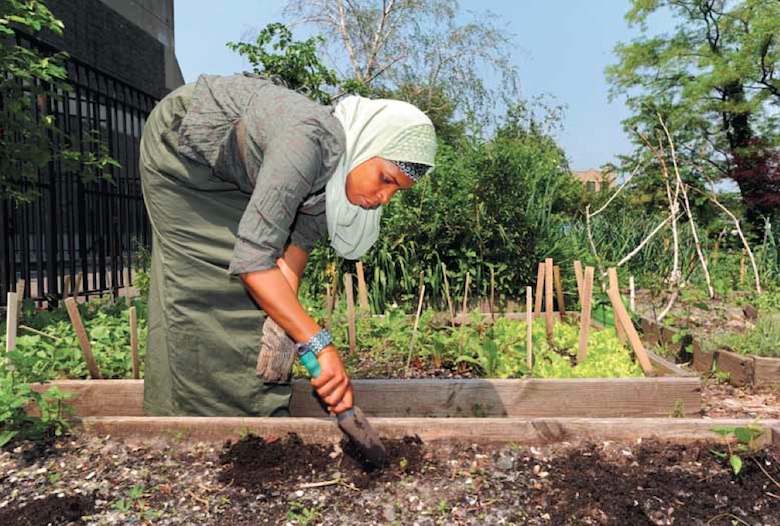
A garden is growing in the Bronx. But this is no ordinary square of soil. On 174th Street and East Tremont Avenue, Drew Gardens is a place of peace for new New Yorkers who arguably need it most: refugees from around the world who have fled war and persecution.
“When I came to New York, I felt lost,” recalls Angele, who grew up on her grandmother’s farm in West Cameroon, fled political instability and found refuge in the United States. “All I saw were tall buildings, and I thought, ‘Where am I?’”
This patch of urban earth became her oasis, one where she tends garlic, tomatoes, peppers, even peanuts, which she’ll grind into peanut sauce come September. But she’s put down figurative roots as well. “I have found solace here,” she says. “I sing to my plants, to the grass and the trees. And when I sing, I have hope for a better life.”
Ah Lun, a refugee from Burma who spent four years fighting for political asylum, arrived in New York this spring. He says the garden is a place of serenity that transports him back to the plot where he grew greens, peppers and garlic with his family. “Farming makes me feel more close to my home,” he says. “It’s good for my heart.”
Angele and Ah Lun are just two of the nearly 75 refugees who grow food to nourish both body and soul at this 2.5-acre plot where the harvest—bok choy, corn, mustard greens, water spinach, kale, chard, bitter melon, long beans, amaranth, Thai basil, white African eggplant, Uzbek melons, black-eyed peas and kabocha squash—is as diverse as its farmers: refugees resettled by the International Rescue Committee from the sites of some of the world’s worst humanitarian crises: Cameroon, Bhutan, Burma, Eritrea, Afghanistan and Iraq.
Drew Gardens is part of the IRC’s groundbreaking New Roots program, a network of urban farms for refugees that started in San Diego and has grown to include 400 farmers in Seattle, Phoenix, Salt Lake City, Dallas, Boise, Charlottesville, Baltimore and, most recently, New York City. A second, much larger New Roots garden at the Grand Concourse and East 153rd Street will be ready by spring, equipped with 60 plots, an aquaponic greenhouse (which will grow herbs and fish), coops for chickens and rabbits, and even a small fruit orchard.
The IRC was born in 1933 at the urging of Albert Einstein and today operates in 40 countries. On the ground within 72 hours of an emergency—whether it be war, genocide or natural disaster—the IRC helps people to not only survive, but to rebuild their lives. Its New Roots program was hatched in 2006 by the IRC’s Ellee Igoe, who says many clients tended gardens back home but now find themselves in urban America’s infamous “food deserts.” Michelle Obama, who visited the San Diego garden in 2010, called New Roots a “phenomenal” model for building healthy communities.
That’s because the program yields much more than just beans and bok choy. It aims to create a new paradigm—one that helps feed uprooted refugees, supplements income via on-site markets where gardeners sell the fruits of their labors, and also offers agricultural training, so refugees might pursue employment on a working farm. But as importantly, the gardens ground them, soil to soul, in their new homeland.
Day-to-day, the experience also nurtures relationships. “The gardens play an integral role in helping refugees to integrate into the community,” says Lisa Brochet, IRC’s New York City New Roots coordinator. She says people who grow food quickly find common ground with one another. “You see someone who just arrived from Burma who speaks no English, and in an instant, they are communicating with someone from Iraq. Gardening is a universal language.”
Photo credit: Peter Biro



